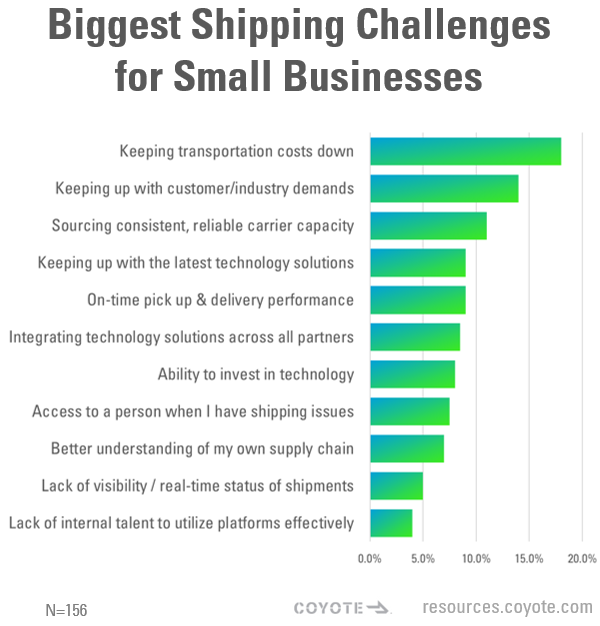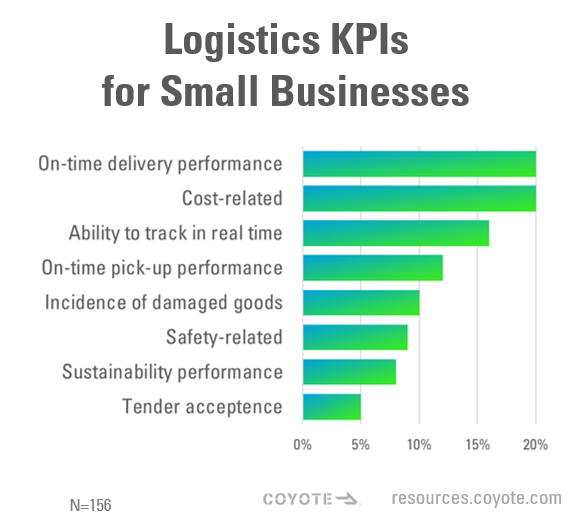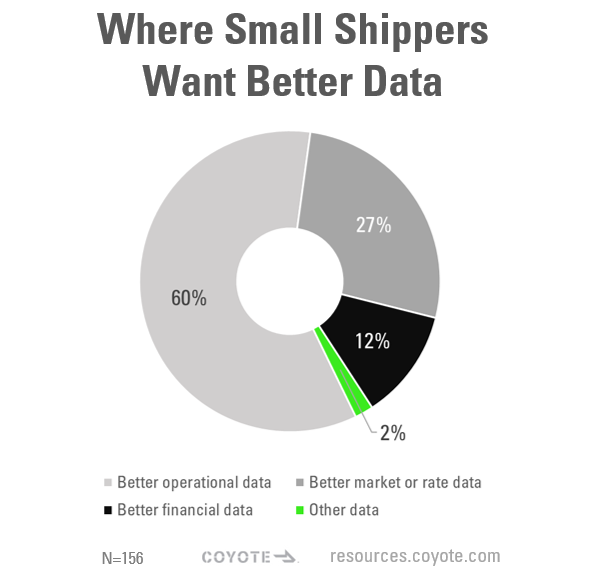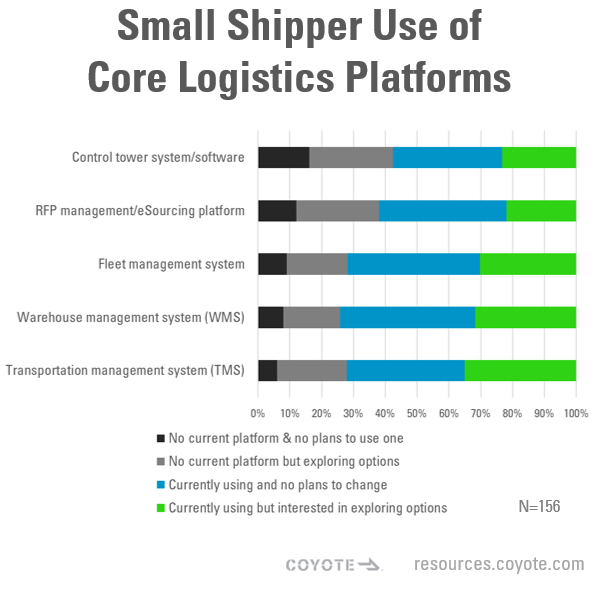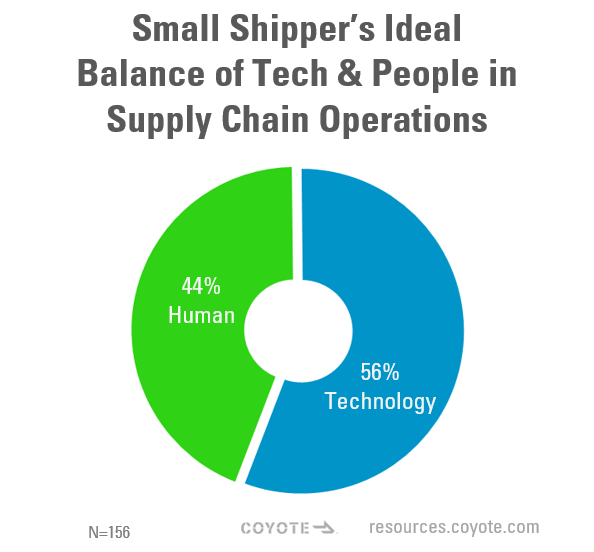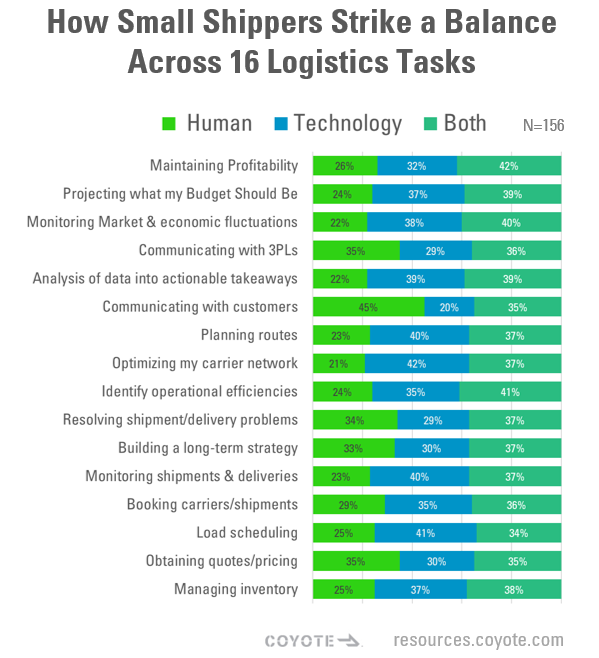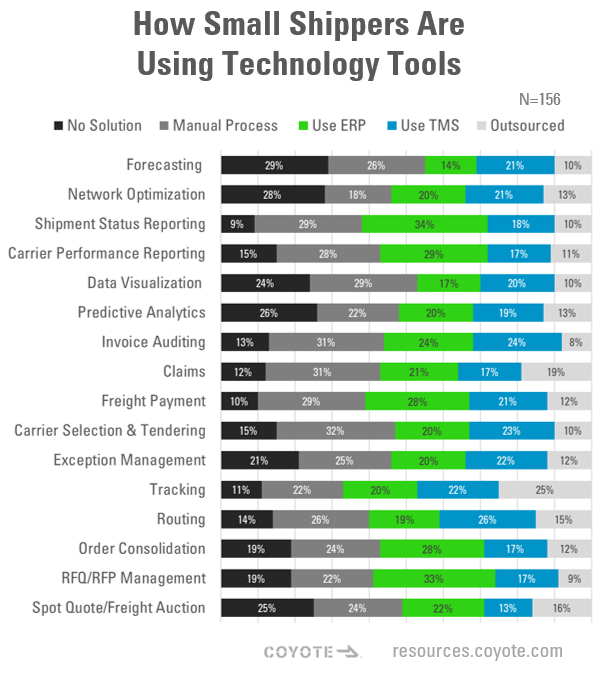The Small Business Guide to Logistics Technology: 5-Steps for Growing Shippers
Are you a logistics professional at a business with annual revenue under $200 million?
Do you feel overwhelmed by the sheer volume of logistics technology options out there?
Small businesses face some tough choices about what, if any, supply chain technology they should adopt.
Whatever solutions you do choose must bring real value to your organization, but how do you know what’s right?
If You Don't Know Where to Start, Ask Your Peers
We asked over 850 supply chain and transportation decision makers — including more than 150 from small businesses — for their insight on what logistics technologies they’re using.
You can download the full study for a deep dive into how global shippers are balancing technology and human expertise, but we wanted to create something just for you — the small, scrappy, growing business.
You might not have the budget (or need) for a control tower, but this five-step guide can help you figure out how to choose the right digital solutions for your supply chain.
Step 1: Assess Your Needs
A great place to begin is by taking stock of your logistics challenges.
What facets of your shipping and logistics operations cause you the most headaches today?
According to the study, small shippers’ number one challenge is keeping transportation costs down.
This was the leading challenge overall for shippers of all sizes, but its impact is particularly pronounced for companies with smaller logistics budgets — small shippers are 33% more likely to choose it as their top challenge compared to their larger peers.
Another major challenge small businesses face is keeping up with customer demands, which also had bigger impact on smaller shippers (they were 18% more likely to select this as a top challenge).
This is due largely to the “Amazon effect” — customers want better, faster and cheaper service in all contexts.
Improving efficiency to meet such high expectations is expensive, whether the solution is increasing headcount or investing in digital solutions.
Step 2: Define Success for You
Once you’ve ranked your current pain points, you need to start thinking about the key performance indicators (KPIs) you use to measure your shipping and logistics performance.
You need a clear idea of what success looks like, and how you’re going to measure it, so you can track the return on your technology investments.
The two most frequently cited KPIs for small businesses were on-time delivery performance and cost-related (delivery cost per shipment, etc.).
Other popular indicators were real-time shipment tracking capabilities, on-time pickup performance and low incidence of damaged goods.
The KPIs that matter most to you will depend on your specific business goals.
For instance, if you ship fragile or hazardous materials, you may be willing to accept a higher cost per shipment than a similarly sized shipper who primarily moves commodity metal products.
Setting your KPIs Is One Thing, Interpreting Them Is Another
The survey revealed that many small businesses lack confidence in their ability to take advantage of available logistics data:
- 75% defined themselves either as data beginners who don’t know where to begin or as intermediate in skill, able to distill some insights from their data but with plenty of room to grow.
- Only 25% replied that they can analyze data and use it to inform tactical decisions at an advanced level.
Regardless of where you fall on this spectrum, it is never a bad idea to assess potential areas for improvement.
Consider whether there is a specific type of data that would really help your organization mature (and what digital tools you’d need to track and measure it).
Small businesses overwhelmingly told us that better operational data would take them to the next level — 60% identified this as their greatest need.
If this sounds like you, it might be time to invest in a software platform such as a warehouse management system (WMS) or transportation management system (TMS) to help you gather and store relevant data so you can use it to improve.
Step 3: Survey Your Options
Selecting logistics technology from the array of options out there is both exciting and daunting.
Knowing where your peers are investing will help you get an idea of what works for a company your size.
More than 50% of small businesses are using the following software platforms:
Other tech options include RFP management/eSourcing platforms and control tower software, but these are not as widely adopted by businesses below the $200 million annual revenue threshold.
While they are powerful tools, they can also be expensive — you may find that your own business structure is not quite so complex that it requires them.
At the end of the day, these platforms are not necessarily must-haves.
As you can see, small businesses vary widely in their adoption of key logistics software, and some who have invested in them already may even be reconsidering their decisions.
The best solution is the one that meets your needs, not necessarily the most popular one in the industry.
Step 4: Set Up Effective Processes and Teams
We cannot overstate how important this step is in creating a successful logistics technology plan.
The most powerful tech tools are only valuable if you can properly use them. Without people and processes, you risk letting your significant investment go to waste.
Biggest Technology Challenges for Small Shippers
Two of the three most common challenges shippers have with supply chain technology tools involve understanding the complex data these tools generate. Small business typically need help with:
- Administering and managing tech tools.
Growing businesses often don’t have anyone on staff who has set up or run a TMS or WMS before. While these software platforms are intended to make your life easier, they end up causing headaches for companies that don’t know the best practices for using them. - Deriving actionable insights from data.
Once your systems are up and running, they will start generating tremendous amounts of data about your operations, facility performance, shipment history and more. It takes expert eyes to understand what this data is telling you about how you can improve your efficiency.
People & Technology: The Balancing Act
These challenges line up with the single most resounding takeaway from our research: Businesses of all sizes, across all verticals, need an effective blend of technology and human support to help them meet their logistics needs.
When asked what the optimal blend between tech and people in supply chain operations was, shippers reported it was 58% technology and 42% human expertise.
Looking only at small businesses, they preferred humans at an even higher rate, favoring a blend of 56% technology to 44% people.
Balancing Across 16 Tasks
In our breakdown of 16 key logistics tasks, we asked how shippers preferred the work be done: by people, technology or both.
Only one task received more than 50% of the vote either way: 57% of small business shippers preferred humans for communicating with customers.
The 5 tasks where small shippers most prefer at least some degree of human involvement:
- Communicating with customers
- Communicating with 3PLs
- Resolving shipment or delivery problems
- Building a long-term strategy
- Booking carriers
It makes sense for businesses that may only make a handful of shipments per year prefer a high-touch approach to communication and issue resolution.
Every single load is make-or-break at this scale, and small businesses need trusted, high-service providers to avoid potentially crippling disruptions in their supply chains.
Step 5: Determine Where You’re Going to Use Your Digital Tools
Not every business does every task the same. Some use an ERP, some use a TMS, many use a homegrown solution or manual process, and some simply go without.
There is no one right way to make use of the digital solutions you have available. But looking at how your peers are doing it can help you determine if you’re on track or need to reassess your strategy.
Here’s a deep dive into how small shippers are using digital freight tools across 16 logistics tasks.
Don’t Be Afraid to Ask for Help
Always remember that you don’t need to go it alone when managing your supply chain needs.
You could choose to invest in technology and supplement it by hiring talent, or upskill your current workforce.
Or you can even rely on outside providers to help you utilize your technology to the fullest or to supplement your own operations by providing data or skilled labor.
And you don’t have to be a large shipper to outsource.
- Small businesses outsource an average of 13% of their supply chain tasks, with tracking being the most outsourced task.
- Outsourcing also applies to data: 33% of small businesses use third-party data, purchasing shipping, logistics, sourcing and procurement, and marketplace data from major data aggregators such as IBM, SAP, Rogers, Google, Facebook and AT&T or from market forecasters like Deloitte.
Small businesses outsource an average of 13% of their supply chain tasks, especially tracking.
Struggling to Keep Costs Down? Get Free Freight Technology
When asked how they prefer to:
- Optimize their carrier networks
- Obtain quotes
- Book carriers
- Plan routes
- Schedule loads
- Monitor shipments and deliveries
…more than 60% of small shippers rely on either an all-digital or partially digital solution.
Did you know that our digital freight matching platform CoyoteGO® can take care of all these tasks for you?
CoyoteGO combines a seamless digital interface with the backing of our experienced team of logistics specialists, so you can get technology when you want it, and people when you don’t.
It can handle your full truckload and LTL shipments, and it’s completely free.
Learn more about CoyoteGO or get signed up today to access a network of more than 75,000 carriers.





